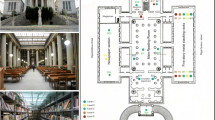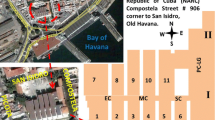Abstract
A study was made of the indoor mycobiota in a range of public and private buildings (libraries, museums, laboratories and offices, warehouses, homes and a school) in the city of Havana (Cuba). Culturable airborne fungi were sampled using a slit-to-agar impactor (Chirana aeroscope). High levels of contamination were recorded, with more than 700 colony-forming units per cubic metre of air in 85% of the buildings sampled, and more than 1,000 in 55% of buildings. Of the 28 genera and 31 species identified, the most common were Aspergillus flavus, Aspergillus niger, Penicillium citrinum, Cladosporium cladosporioides and Cladosporium sphaerospermum. Genus and species diversity was analysed, and new findings were obtained regarding Cuba’s atmospheric ecosystem.



Similar content being viewed by others
References
Aira, M. J., Jato, V., Stchigel, A. M., Rodríguez-Rajo, F. J., & Piontelli, E. (2007). Aeromycological study in the Cathedral of Santiago de Compostela (Spain). International Biodeterioration and Biodegradation, 60, 231–237.
Aira, M. J., Rojas, T. I., & Jato, V. (2002). Fungi associated with three houses in Havana (Cuba). Grana, 41, 114–118.
Arnold, G. R. W., Guerra, A. G., & Rodríguez, N. (1987). Presencia de hongos en el aire del INIFAT. Reporte de Investigación. Revista del Instituto de Investigaciones en Agricultura Tropical “Alejandro De Humboltd”, 43, 3–7.
Barnett, H. L., & Hunter, B. B. (1998). Illustrated genera of imperfect fungi (4th ed.). USA: APS Press. The American Phytopathological Society.
Borrego, S., Guiamet, P., Gómez de Saravia, S., Batistini, P., García, M., Lavín, P., et al. (2010). The quality of air at archives and the biodeterioration of photographs. International Biodeterioration and Biodegradation, 64, 139–145.
Borrego, S., Pons, V., & Perdomo, I. (2008). La contaminación microbiana del aire en dos depósitos del Archivo Nacional de la República de Cuba. Revista del Centro Nacional de Investigaciones Científicas. Ciencias Biológicas, 39(1), 63–69.
Burge, H. A. (2002). An update on pollen and fungal spore aerobiology. Journal of Allergy and Clinical Immunology, 110(4), 544–552.
Cadrecha, J., & Fernández, J. (1955). Numbers and kinds of airborne, culturable fungus spores in Havana, Cuba. Journal of Allergy, 26(2), 150–152.
Castañeda, R. F., Fabré, D. E., Parra, M. P. P., Pérez, M., Guarro, J., & Cano, J. (1996). Some airborne conidial fungi from Cuba. Mycotaxon, 60, 283–290.
Codina, R., Fox, R. W., Jockey, R. F., de Marco, P., & Bagg, A. (2008). Typical levels of airborne fungal spores in houses without obvious moisture problems during a rainy season in Florida, USA. Journal of Investigational Allergology and Clinical Immunology, 18(3), 156–162.
De Hoog, G. S. (1996). Risk assessment of fungi reported from humans and animals. Diagnosis, therapy and prophylaxis of fungal diseases. Mycoses, 39(11/12), 407–417.
De Lucca, A. J. (2007). Harmful fungi in both agriculture and medicine. Revista Iberoamericana de Micología, 24, 3–13.
Domsch, K. H., Gams, W., & Anderson, T. H. (1993). Compendium of soil fungi (Vol. I). Eching, Germany: IHW-Verlag.
Ellis, M. B. (1971). Dematiaceous hyphomycetes. Kew, Surrey, England: Commonwealth Mycological Institute.
Esquivel, P. P., Mangiaterra, M., Giusiano, G., & Sosa, M. A. (2003). Microhongos anemófilos en ambientes abiertos de dos ciudades del nordeste argentino. Boletín Micológico, 18, 21–28.
Guglielminetti, M., Valoti, E., Cassini, P. P., Taino, G., & Caretta, G. (2001). Respiratory syndrome very similar to extrinsic allergic alveolitis due to Penicillium verrucosum in workers in a cheese factor. Mycopathologia, 149(3), 123–129.
Hedayati, M. T., Mayahi, S., Aghili, R., & Goharimoghadam, K. (2005). Airborne fungi in indoor and outdoor of asthmatic patients’ home, living in City of Sari. Iran Journal of Allergy Asthma and Immunology, 4(4), 189–191.
Herrera, L., Carrazana, D., & Quiñones, R. (2003). Los hongos anemófilos de la ciudad de Santa Clara, Cuba. Centro Agrícola, 3(30), 78–83.
Ho, M. H. M., Castañeda, R. F., Dugan, F. M., & Jong, S. C. (1999). Cladosporium and Cladophialophora in culture: Descriptions and an expanded key. Mycotaxon, 72, 115–157.
Horner, W. E., Worthan, A. G., & Morey, P. R. (2004). Air and dust-borne mycoflora in houses free of water damage and fungal growth. Applied and Environmental Microbiology, 70, 6394–6400.
Klich, M. A., & Pitt, J. I. (1994). A Laboratory guide to the common Aspergillus species and their teleomorphs. Commonwealth Scientific and Industrial Research Organization. 116 p.
Labarrere, N., Gómez, A., Avila, I., Guevara, M. E., & Fernández, B. (2003). Riesgos biológicos en ambientes confinados. Revista Cubana de Salud y Trabajo, 4(1–2), 4–7.
Lugauskas, A., Levinskaite, L., & Peciulyte, D. (2003). Micromycetes as deterioration agents of polymeric material. International Biodeterioration and Biodegradation, 52(4), 233–242.
Maggi, O., Persiani, A. M., Gallo, F., Valenti, P. P., Pasquariello, G., Sclocchi, M. C., et al. (2000). Airborne fungal spores in dust present in archives: Proposal for a detection method, new for archival materials. Aerobiologia, 16, 429–434.
Mateus, J., Peña, D., Peña, G., Rojas, A., Rojas, J., Zambrano, S., et al. (2004). Seguimiento y control de biodeterioro microbiológico en documentos de interés histórico en el archivo General de la Nación. Universitas Scientiarum, 9(1), 37–46.
Medrela-Kuder, E. (2003). Seasonal variations in the occurrence of culturable airborne fungi in outdoor and indoor air in Craców. International Biodeterioration and Biodegradation, 52(4), 203–205.
Pasanen, A. L., Pasanen, P. P., Jantunen, M. J., & Kalliokoski, P. P. (1991). Significance of air humidity and air velocity for fungal spore release into the air. Atmospheric Environment, 25(2), 459–462.
Pasanen, A. L., Rautiala, S., Kasanen, J. P. P., Raunio, P. P., Rantamaki, J., & Kalliokoski, P. P. (2000). The relationship between measured moisture conditions and fungal concentrations in water-damaged building materials. Indoor Air, 10(2), 111–120.
Pitt, J. I. (2000). A Laboratory guide to common Penicillium species (3rd ed.). North Ryde, Sydney: Food Science Australia.
Ponce-Caballero, C., Cerón-Palma, I. M., López-Pacheco, M., Gamboa-Marrufo, M., & Quintal-Franco, C. (2010). Indoor-outdoor fungal aerosols ratios of domestic homes in Merida, Mexico. Ingeniería, 14(3), 169–175.
Portugal, N. M. A., Videira, S., Eccheverria, S. R., Bandeira, A. M. L., Santos, M. J. A., & Freitas, H. (2009). Fungal diversity in ancient documents. A case study on the Archive of the University of Coimbra. International Biodeterioration and Biodegradation, 63, 626–629.
Reponen, T. (1995). Aerodynamic diameters and respiratory deposition estimates of viable fungal in mold problem dwellings. Aerosol Science and Technology, 22, 11–23.
Reponen, T., Nevalainen, A., Jantunen, M., Pellikka, M., & Kalliokoski, P. P. (1992). Normal range criteria for indoor air bacteria and fungal spores in a subarctic climate. Indoor Air, 2, 26–31.
Rojas, T. I., Llanes, N., Benítez, M., Aira, M. J., & Malagón, H. (2007). El género Aspergillus en la atmósfera de La Habana (Cuba). Boletín Micológico, 22, 41–46.
Rojas, T. I., Martínez, E., Aira, M. J., & Almaguer, M. (2008). Aeromicota de ambientes internos: Comparación de métodos de muestreo. Boletín Micológico, 23, 67–73.
Rojas, T. I., Martínez, E., Gómez, Y., & Alvarado, Y. (2002). Airborne spore of Aspergillus in cultural institutions at Havana University. Grana, 41, 190–193.
Samson, R. A., Hoekstra, E. S., Frisvad, J. C., & Filtenborg, O. (2002). Introduction to food and airborne fungi (6th ed.). Utrecht: Centraalbureau voor Schimmelcultures.
Sánchez, A. I., Martínez, P., Borrego, S., & Brizuela, A. L. (1988). Estudio de la contaminación fúngica en vigas de madera de la iglesia del Espíritu Santo: Monumento Nacional. Revista Cubana de Biología, 11(3), 16–33.
Seidel, D., & Rauber, A. (1970). Beobachtungen uber den Flug von Pilzsporen auf Kuba. Beit zur trop u subtrop. Landwirt u. Tropenvet, 8, 43–50.
Shelton, B. G., Kirland, K. H., Flanders, W. D., & Morris, G. K. (2002). Profiles of airborne fungi in buildings and outdoor environments in the United States. Applied and Environmental Microbiology, 68(4), 1743–1753.
Singh, A., Ganguli, M., & Singh, A. B. (1995). Fungal spores are an important component of library air. Aerobiologia, 11(4), 231–237.
Vaillant, M., Chi, L., & Sánchez, A. I. (1989). Sobre la contaminación microbiológica existente en depósitos del Archivo Nacional. Documentos, 2, 44–65.
Acknowledgments
The authors sincerely thank María Benitez Roselló for their collaboration in the experimental part of this paper.
Author information
Authors and Affiliations
Corresponding author
Rights and permissions
About this article
Cite this article
Rojas, T.I., Aira, M.J. Fungal biodiversity in indoor environments in Havana, Cuba. Aerobiologia 28, 367–374 (2012). https://doi.org/10.1007/s10453-011-9241-z
Received:
Accepted:
Published:
Issue Date:
DOI: https://doi.org/10.1007/s10453-011-9241-z




